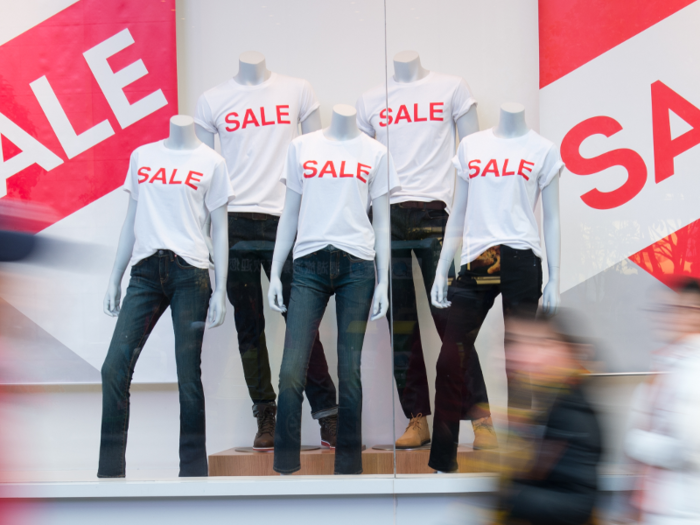
Stores use big, bold "sale" sign to bait shoppers and draw them into the store, even if they weren't planning on it.

By stating an offer is limited or won't last long, it prompts shoppers to act right away, causing them to buy things they weren't necessarily planning on.

Its easier to overspend when you can put everything in a big shopping cart instead of having to carry it all.

The bright colors of fresh produce tend to put people in a good mood, so they think more highly of the store and end up spending more.

Having baked goods and flowers at the front of the store has the same effect that the produce does. All of the bright colors and good smells make shoppers happy, so they spend more because they're in a good mood.

Playing calming music makes people slow down, even if they don't realize it. They spend longer in the stores, and inevitably end up buying more.

Warm, calming colors invite people into stores and make them feel welcomed, putting them in a better mood and making customers more willing to shop.

Milk and dairy products are very popular, so stores place them all the way in the back, forcing customers to make their way though the rest of the store and fill their carts with items they may have avoided otherwise.

Again, by rearranging the store, companies force customers to wander through the store longer to find what they need, leading to customers buying more than they needed.

Because most people are right handed, and Americans drive on the right side of the road, most people move through a store from right to left. Stores design displays in accordance to this.

Stores place what they want you to buy right at eye level so that you have to see them, and end up being more tempted to buy them.

Free samples encourage shoppers to buy what they tasted, because people feel guilty if they take free samples and they don't buy the product. It also opens shoppers up to trying things they otherwise wouldn't have bought.

Bigger stores are more comfortable to shop in, so even smaller stores aim to feel spacious to encourage customers to spend more time in-store.

Stores stock up the front of the store with candy, magazines, and other small products that prompt last-minute buys.

Smartphone apps send a constant flood of notifications to people's phones with special deals and alerts that encourage people to shop online or in-store right away so they get the best deals, even if they didn't plan on shopping.

Likewise, email notifications encourage people to go shopping as soon as possible to get the best deals.

If you spend $35, but a store is offering free shipping if you spend $50 or more, most people will spend the extra $15 to avoid paying $5 of shipping.

Products are tagged at $1.99 instead of $2.00, because people tend to round down if they see the .99 and end up buying more expensive products.

People tend to impulse-buy more when they don't spend 10 minutes filling out their card info and thinking about what they're buying, so with one-click ordering its easier to spend without thinking.

Returns and refunds take the risk out of buying, because if you don't like the product it can be returned for free and you'll get your money back.

If employees see you with a product, they sometimes suggest a complementary product to go with it. And to be nice, many people will take the suggestions and end up buying more than they wanted to.

Some employees are told to treat customers like family, because then customers feel guilty walking away from the store without buying something.

At luxury stores, snobbish salespeople tend to make customers feel like they aren't part of the exclusive group of people who shop there, making people more inclined to buy something so they can fit in.

When people feel nostalgic, they value money less and are willing to spend more.

Ads on social media are targeted specifically towards you based on past purchases, drawing you back in and trying to prompt you to buy more similar products.

When you have a company credit card, not only do you feel more loyal to that store and inclined to go back, but you're encouraged to spend more money to get more rewards.

Coupons encourage people to spend more money than they may have initially, because they're willing to buy products they wouldn't usually under the illusion that they're getting a "deal."
 I spent $2,000 for 7 nights in a 179-square-foot room on one of the world's largest cruise ships. Take a look inside my cabin.
I spent $2,000 for 7 nights in a 179-square-foot room on one of the world's largest cruise ships. Take a look inside my cabin. Saudi Arabia wants China to help fund its struggling $500 billion Neom megaproject. Investors may not be too excited.
Saudi Arabia wants China to help fund its struggling $500 billion Neom megaproject. Investors may not be too excited. Colon cancer rates are rising in young people. If you have two symptoms you should get a colonoscopy, a GI oncologist says.
Colon cancer rates are rising in young people. If you have two symptoms you should get a colonoscopy, a GI oncologist says. Indian Army unveils selfie point at Hombotingla Pass ahead of 25th anniversary of Kargil Vijay Diwas
Indian Army unveils selfie point at Hombotingla Pass ahead of 25th anniversary of Kargil Vijay Diwas
 IndiGo places order for 30 wide-body A350-900 planes
IndiGo places order for 30 wide-body A350-900 planes
 Markets extend gains for 5th session; Sensex revisits 74k
Markets extend gains for 5th session; Sensex revisits 74k

Copyright © 2024. Times Internet Limited. All rights reserved.For reprint rights. Times Syndication Service.